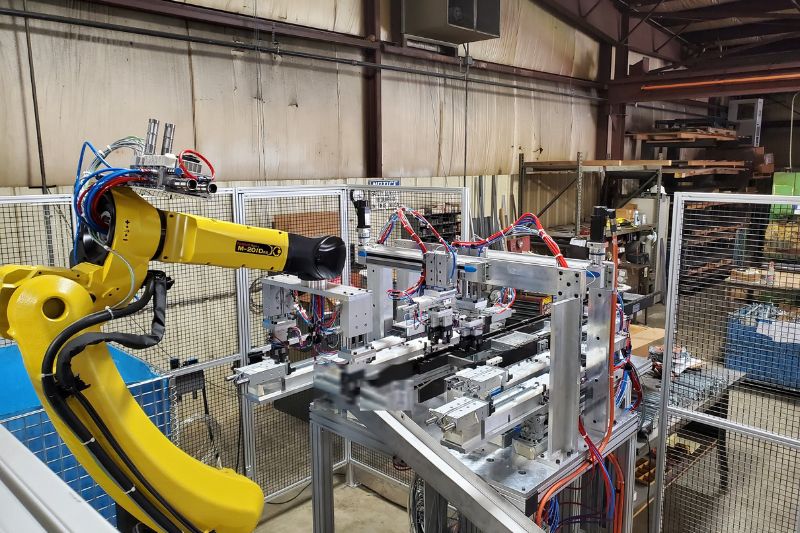Robotic Process Automation in a Post-Pandemic World: A Case Study
A new reality has settled upon us in nearly every industrial environment.
Hit by supply chain issues from one direction and the Great Resignation from the other, you must do more with less, maximize the use of the resources that you have, maintain order and harmony during a post-pandemic, world-wide mental health crisis, and all on top of what you did before.
With initial discussions happening just before lockdown, one manufacturer was just ahead of what was to come. On-site meetings with their team allowed us to observe the existing assembly process that relies upon a full-time laborer on each shift of production. The laborer pairs and connects a male and female stamped metal part. The work is slow, repetitive, and mundane, and no one wants the assignment. Automating the process had the potential to greatly increase production, provide predictable output, reduce reliance on an unstable workforce, and free up manpower to oversee the resulting, more efficient process.
Plant managers rely on being able to maintain order and have control over their environment. They require organization and reliability. Being able to automate this process frees up time and energy for them to manage other concerns within the plant.
We had worked with this customer before on smaller projects but were itching for an opportunity to demonstrate our abilities, to really shine and showcase our strengths. Our persistence paid off. We were shown a problem that would require the development of a custom, integrated solution. It addressed all of the problems laid out up front and others that were discovered along the way.
It is about growing trust with each opportunity along the way, no matter how small. When you knock it out of the park, you know they’ll come back.
A New Partnership
The project serves as a great example of the expanded capabilities of Axis resulting from their January 2022 acquisition of select Leader Engineering Fabrication. The purchase included a skilled and professional staff, and a 24,000 square foot manufacturing facility with fabrication and assembly areas, a machine shop and a paint booth. Although the project began ahead of the acquisition, the relationship between Axis and Leader has been developing for several years through a number of collaborative efforts for clients.
This project created an ideal opportunity for a synergy, requiring custom machine building/fabrication and assembly, electrical & mechanical schematics & design, and HMI, PLC, robotics, and servo programming, all now performed in-house. With expanded capabilities, Axis can now perform all of the necessary services to streamline and centralize all aspects of the project to one location, enhancing efficiency, and reducing coordination efforts, travel, and opportunities for errors.
The Solution
The development of a solution utilized input from the manufacturer’s engineering and maintenance departments. Regular progress meetings were handled virtually during COVID as well as concept, proposal review, and design review meetings. Factory acceptance tests (FATs) were held on-site at Axis’ fabrication facility allowing equipment demonstrations and test runs. Delivery of an optimal, customer driven solution depends on collaboration with the people who understand the process, the environment and the challenges.
The new system retrieves both a male and female part from a 300-ton progressive die press with a 2 second cycle time, maintaining proper orientation and spacing. Parts are transported using a walking beam with two servo thrusters controlling the vertical and horizontal travel from the press. This capture from the press must happen as the two parts drop but before the parts begin to rotate. Timing must be synchronous with the press opening and closing. Axis equipment has less than two seconds to enter the press, capture the parts and remove the parts, or damage can result to either the press or the walking beam.

Next, each pick-and-place unit picks up two complementary parts from the walking beam and loads them into the first position of the assembly station, repeating the loading process for the second position. A crowder cylinder extends to push first position and second position parts together to complete the assembly. A six-axis Fanuc robot then picks up four assembled parts and places them into one of two dunnage totes. Equipping the system with two dunnage locations allows for a continuous, uninterrupted process once a tote reaches capacity and requires a forklift for change out.
The Hurdles
The specs dictated an aggressive cycle time of four seconds for two assemblies (4 parts) as well as the need to successfully accommodate three different part types without a tooling change. With different part types having different centers of gravity, maintaining proper orientation of each, at the speed they are required to travel, was critical.

The Results
The new system has the ability to produce in excess of 4 times the current production volume enabling the manufacturer to respond to anticipated increase in demand and market conditions. Also, oversight of this process is far easier to staff than manual assembly.
This situation is in no way out of the ordinary in a manufacturing environment. At every operation of a production line there is opportunity for improved efficiencies. Regardless of industry, manufacturers are investing in automation and vision systems to increase productivity, increase quality and reduce reliance on an unpredictable workforce.
If you have a productivity concern or a system you would like to automate, contact us.

Complimentary Evaluation
See what the Axis Approach can do for your facility.

Complimentary Evaluation
See what the Axis Approach can do for your facility.
